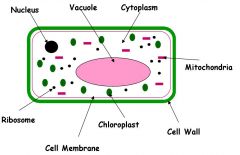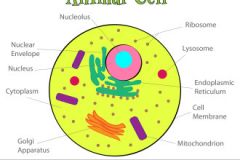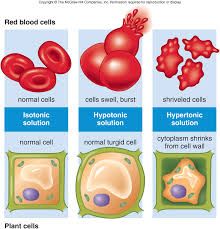![]()
![]()
![]()
Use LEFT and RIGHT arrow keys to navigate between flashcards;
Use UP and DOWN arrow keys to flip the card;
H to show hint;
A reads text to speech;
32 Cards in this Set
- Front
- Back
|
Structures of a Plant Cell |

*Cell Wall *Cell Membrane *Nucleus *Mitochondria *Chloroplast *Ribosomes *Cytoplasm |
|
|
Structures of a Animal Cell |

*Cell Membrane *Nucleus *Mitochondria *Ribosomes *Cytoplasm |
|
|
Prokaryotic Cells |
*No Nucleous (Bactria) |
|
|
Both |
*Cyoplasm *Ribosomes *DNA *Cell Membrane |
|
|
Eukaryotic |
*Vacuoles
*Chloroplast |
|
|
Compare Plant and Animal Cells |
*Cell Membrane *Mitochondria *Ribosomes *Nucleus |
|
|
Contrast Plant and Animal Cells |
Plant- From a Plant *Cell Wall *Chloroplast Animal-From an Animal |
|
|
Cell Wall |
Present in plants, algae, fungi, and many prokaryotes. They lie outside of the membrane. Most of them are porous enough to have water, oxygen, carbon dioxide, pass through it easily. |
|
|
Cell Membrane |
Regulates what enters and leaves cell and also provides protection and support. It also keeps plant cells from bursting. |
|
|
Cytoplasm |
It contain cell organells and gives a cell shape. It also has chemical reactions taking place inside it |
|
|
Nucleus |
It controls cell devision, developement and itś activity. |
|
|
Ribosomes |
Contains a partical called RNA that make protein. |
|
|
Mitochondria |
Contians chemical energy. |
|
|
Vacuole |
Stores things |
|
|
Chloroplast |
They trap light energy for photosynthisis. (Contain Chlorophyll) |
|
|
Levels of Organization |
*Atoms *Molecule *Organelles *Cells *Tissue *Organ *Organ System *Organism |
|
|
Atoms |
Tiny particles of matter. *Over 100 Different types (elements=atoms) *Major atoms of life are C, H, N, O, P, & S |
|
|
Molecule |
Two or more atoms band, or glued, together. *Tiny molecule= water(H20) *Bigger molecule=protein, carbohydrate, lipid, DNA |
|
|
Organelles |
Molecules conbine to form speaciaized parts inside of cell. *Different types of organelles *Different types of jobs work together to make cell work. |
|
|
Cells |
Smallest unit of life *Unicellular organism-one cell does all jobs. *Multicellular organism-different types of cell do differents jobs. |
|
|
Tissue |
Group of similar cells, all doing the same jobs. |
|
|
Organ |
A Complete part inside of a multicellular organism that does a specific job. *Examples- Heart, Brains, Lungs |
|
|
Organ System |
Group of related parts working together to complete a task. |
|
|
Organism |
One individual living thing thatś made up of lots of intercting parts. |
|
|
Examples of Multicellular Organisms Specialized Cells |
Animal- *Muscle *Red Blood Cell Ciliated Cell Plant- *Root Hair Cells *Xylem Cells |
|
|
Diffusion |
Movement of substance across a membrane from a region of a lower concentration to a higher concentration. *Using energy |
|
|
Alveoli of Lungs |
Oxygen From alveoli into blood capillaries |
|
|
Alveoli of Lungs
|
Carbon Dioxide From blood capillaries into alveoli |
|
|
Alveoli of Lungs
|
Oxygen From the air spaces, through stomata into the atmosphere, during photosynthesis |
|
|
Things that Speed up Diffusion |
*Temperature *Size of molecules *Consentration |
|
|
Osimosis |
Passage of water from a region of its higher concentration to lower concentration through membrane. *Form of diffusion |
|
|
How does osmosis affect Plant and Animal Cells |

|

